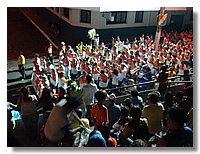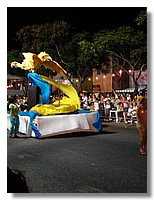|
|
Samba schools parade in Natal, Brazil
«Back to Home
«Hotels in Natal
«Entertainment in Natal
«Carnaval in Natal
Despite having a quiet carnival, Natal has maintained a tradition of promoting a parade of samba schools, similar (albeit much smaller) to the Carnival in Rio. For the past years, the parade has been happening on Avenida Duque de Caxias, near the Port of Recife and Avenida Chile.
The Parades (in Portuguese, Desfile de Escolas de Samba) happens in the evenings of Saturday, Sunday and Monday. Each parade starts around 8 pm, and finishes around 2 am. About 8 schools parade each evening; the performances of the schools are juried by a comission (Historic note: sometime early in the past century, there was some prejudice against people who participated of samba; to minimize the bad image, some leaders of samba groups called themselves "schools", even though not much is taught).
It's evident that the Desfile in Natal doesn't have the fame, size or luxury of Rio. However, for those who just want to see what carnival parade is about, Natal has some advantages: it is free; it is safer (basic caution, like not exposing your valuables, is still necessary); it is quieter.
The photos below show a little of the parade which happened on Saturday, Feb. 25th 2006.

|

|

|
|
There are two sets of seats in stadium-like structures (in Portuguese, "arquibancadas"); the assemblying is made by professionals and verified by the firemen. There are another two elevated structures, one for the jury, other for the authorities. Entrance is free, there are no reservations; who comes first, seats first. The images below give an idea of the excellent visibility. Each school parades along about 500 meters, taking about 20 minutes.
|

A school is passing by. Along most of the parade, a small fence or a tight rope separates the schools from the audience.
|

There are plenty of carts selling hot dogs, beer, coconuts, etc. Prices do not have the usual tourist mark-up of Ponta Negra.
|

Some beer sellers make tables and chairs availables to customers.
|

The arquibancadas, seen from ground level.
|

Indians are a constant presence in the carnival of Natal. Every night, at least one tribe parades.
|

Indians don't play samba; instead, they play their own instruments and rythms.
|

The authorities stand. The man in blue is the Mayor of Natal, Carlos Eduardo Alves. The Governor of Rio Grande do Norte, didn't attend the parade in the first night, but she came in following nights.
|

The parade of a samba school is similar to those in Rio: large dummies (above, an yellow eagle), samba, people singing and dancing.
|

Another view of the Eagle. The grandness and beautiness of the dummies is taken into account by jurors.
|

By combining the song, the costumes, the dummies, each school tells a story (in Portuguese: enredo). The division of each school in blocks, the costumes each block wears, the choreography, all must be related to the story being told. The cohesion among all these elements is a relevant factor to the jurors.
|

Regardless of the story being told, some characters must be present in every school. It's the case of the bahianas, women from the Brazilian State of Bahia, who are said to have a strong spiritual force.
|

Beautiful women are not a requirement, but they are always present. The photo above is more blurred than the others because the girl moves too fast.
|

This large picture is a snapshot of a short movie; unfortunately, the 24 second movie is 8.60 MB, too large to be published here.
Back to Top
|
|
















